#imamiya ebisu
Text
A mai első szentélyem a Sukunahikona Jinja volt. Egy aranyos kis szentély, ami modern irodaházak közt bújik meg. Itt Sukunahikona-no-Mikoto és Shinno-Entei, a gyógyítás és a gyógyszerek Kamijai laknak. Ez a hely nemcsak azért volt különleges, mert 300 yenért nagyon szép goshuint kaptam, de azért is, mert konkrétan egy kis csoda is történt velem.
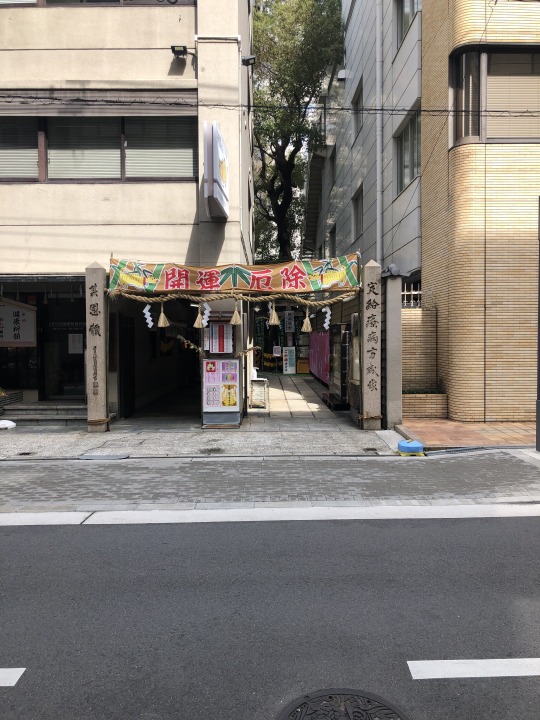



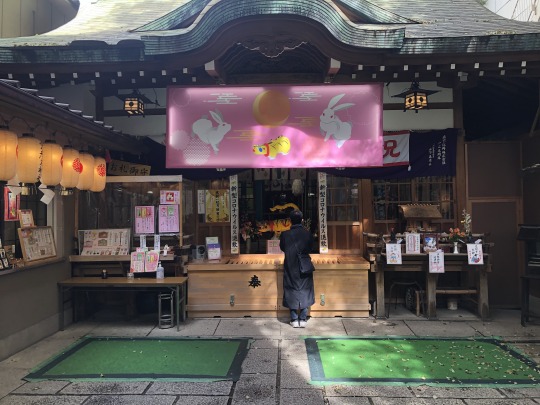

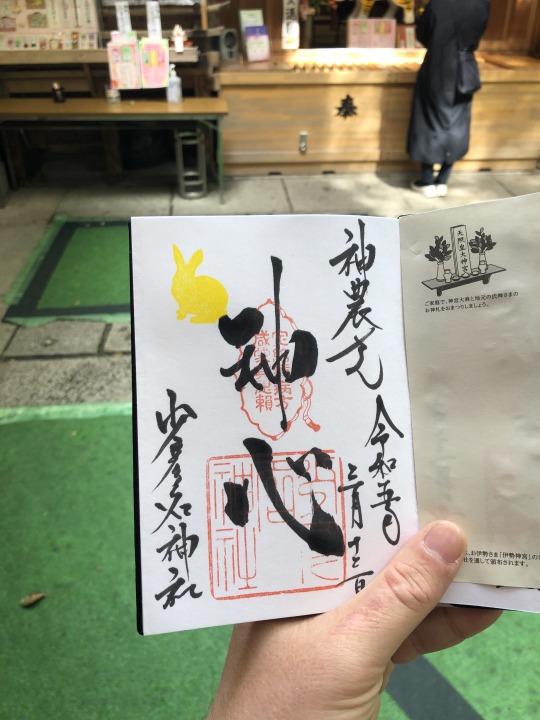
Egész pontosan annyira tetszett a szentély hangulata, hogy gondoltam, veszek egy omamorit is. Általában ahol eddig jártam, ott egy omamori olyan 600-1000 yen közötti áron volt kapható, szóval teljesen nyugodt szívvel tettem le az asztalra egy ezrest, a miko azonban hatalmas elnézéskérések közepette közölte velem, hogy sajnos keveset adtam, mert a választott omamori 1800 yen. Egy pillanatra kikerekedett a szemem, de úgy voltam vele, hogy hát kellemes a szentély hangulata, kedvesek a mikok és szép goshuint kaptam, szóval egyszer mindenképp belefér. Legfeljebb olcsóbb vacsorát eszek. Ezután elindultam a következő helyre. Úgy öt perce sétáltam, amikor oldalra nézetem és - még most is nehezen hiszem el, de - a csatornában ott úszott mellettem 1000 yen. Felvettem és szétnéztem hogy nem körülöttem hagyta-e el valaki, de csak mögöttem jöttek emberek, akiké nem lehetett, mert hát a víz a másik irányból hozta. Konkrétan annyira meglepődtem, hogy legalább fél percre teljesen lefagytam. Nem tudom szavakba önteni, mennyire boldog voltam, és persze nem amiatt, hogy pénzt találtam, mert nyilván 1000 yen mínuszban is túlélném a hátra lévő 4 hetet. Hanem hát gondolom értitek. Nagyon-nagyon sajnálom ilyenkor azokat, akik a világon semmiben sem hisznek, mert nekem már konkrétan csak emiatt az élmény miatt is megérte volna 9000 kilométert utaznom.

A második szentély a Hirota Jinja volt, ami egy nagyon szép és rendezett szentély. Szégyen és gyalázat, de pontosan nem tudom az itt "elszállásolt" Kami nevét. A pap viszont itt is nagyon kedves volt és még meg is dátumozta a goshuint.
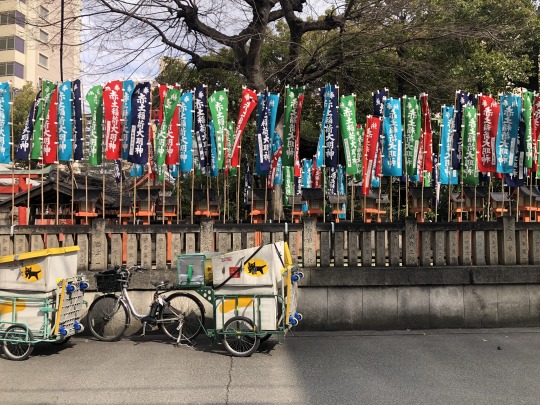
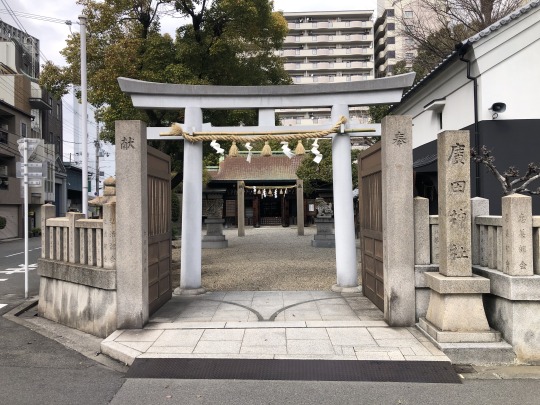
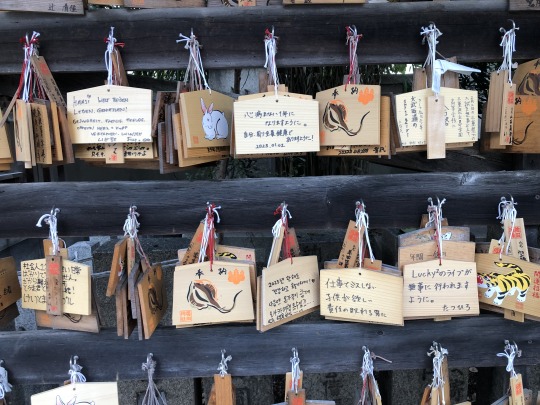
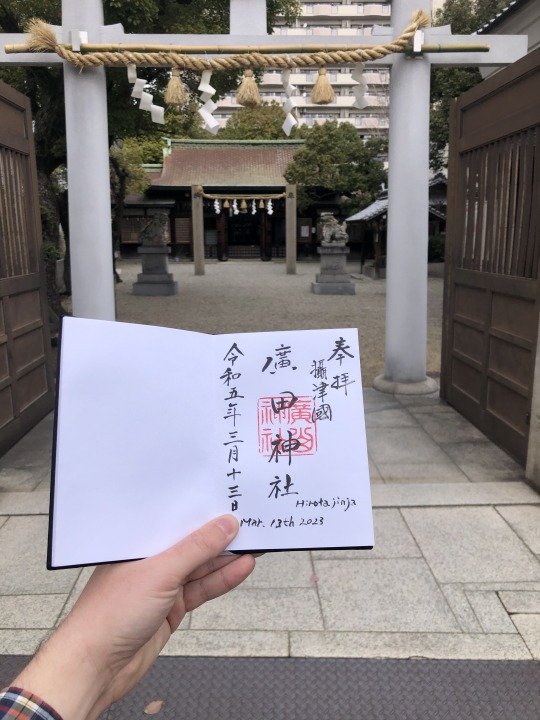
A harmadik szentély az Imamiya Ebisu Jinja volt, ahol Ebessan, a kereskedelem oszakai Kamija lakik, de több Kamit is tisztelnek itt, például Ebisut, a halászok és a jó szerencse Kamiját.
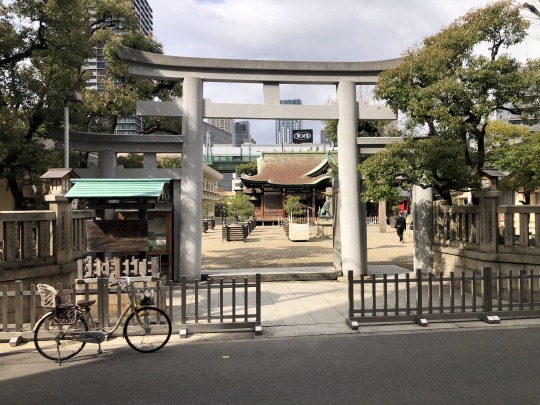




Az utolsó szentélybe teljesen véletlenül futottam bele, de vétek lett volna kihagyni. Az Ooe-Jinja az egyik legcsodálatosabb élmény eddig. Hogy miért? Hát nézzétek meg a mikokat, akik az irodában fogadtak!:3


Rajtuk kívül egy nagyon kedves papnő volt a szentélyben, akitől ezt a nagyon menő cicás goshuint kaptam. Ahogy utólag utánaolvastam, ez egy nagyon régi szentély, amit valamikor a hetedik század végén alapítottak, eredetileg Toyouke-Ōmikami otthona, de többek közt az eredetileg buddhista gyökerekkel rendelkező Bishamonten előtt is tisztelegnek itt. És mint sok más helyen, természetesen egy kis Inari szentély is található a területen.

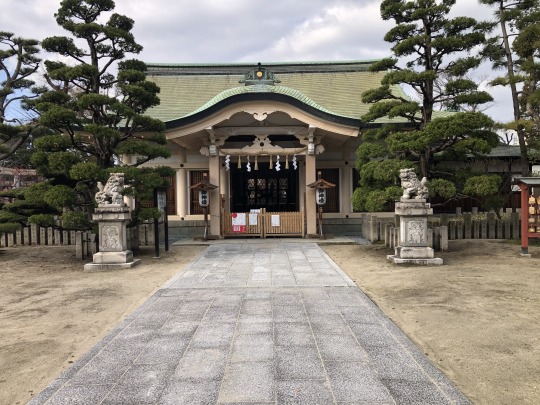

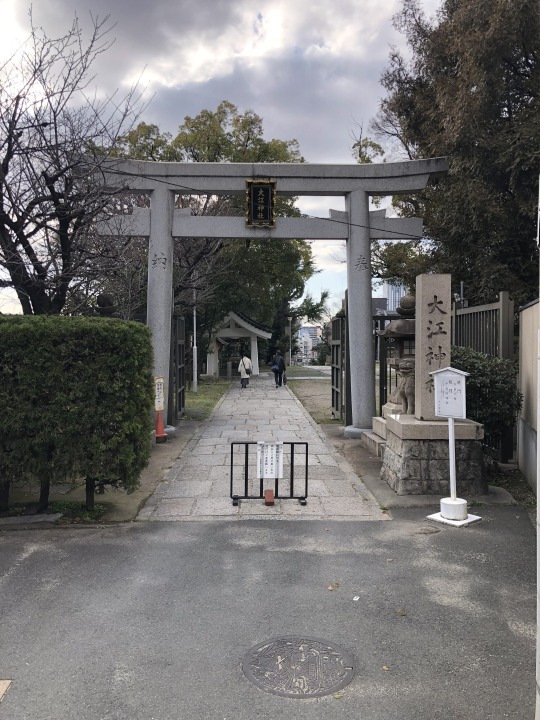
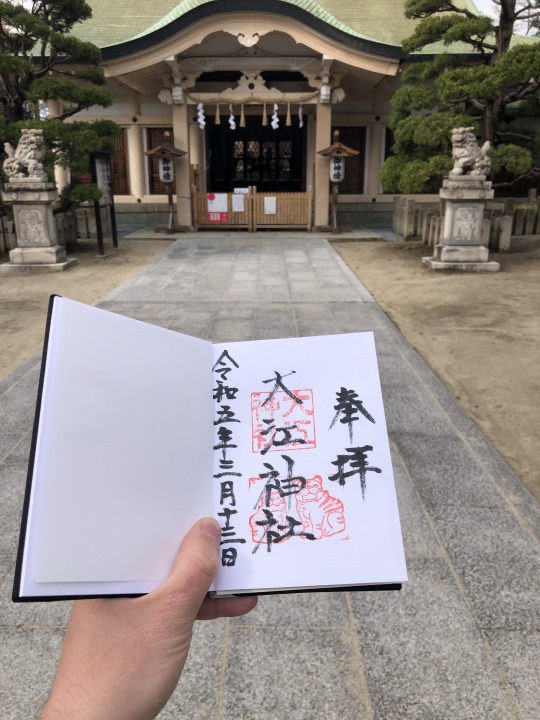
Végül pedig van egy kakukktojásom, mert szerettem volna megnézni egy kisebb buddhista templomot is. Ez a Toji-ji templom lett, ami igazából egy-két apróságot leszámítva (például a füstölőket) szinte megszólalásig hasonlított egy sintó szentélyhez.



Az alábbi két csodát (ezek nem ám modern printek, hahó!) pedig összesen 1750 yenért vettem egy antikváriumban, ahol rengeteg fametszetet és akvarellt lehetett kapni. Nagyon nagy esélyt látok arra, hogy ha hazamegyek, a lakás tele lesz ukiyo-e képekkel (a belógó zoknimért pedig elnézést kérek).

20 notes
·
View notes
Video
youtube
【4K/大阪散歩】大阪市浪速区今宮戎神社「十日戎」を街歩き Walking around Imamiya Ebisu Shrine Toka E...
0 notes
Photo

[2023-01-09] Toka Ebisu Festival Happy New Year! Although by the time you read this it's probably already well into February... It took me a while to get through the picture backlog. Anyway, I didn't do anything in particular for New Year, but I did end up going to a meetup with some online friends in Kyoto. Since my days off are usually on the Sundays and Mondays, I often stay for the night to do some fancy traveling in Kyoto on the Monday. As it turns out, there happened a festival on this very weekend: the Toka Ebisu Festival. In fact it was my mom who informed me about this. Thanks mom! To summarize shortly, the Ebisu is the god of prosperity. For good luck, people buy fortune bamboo grass to provide luck for the year. At the same time, lucky charms of the previous year are collected and burned at a later date. I google'd which shrines are most popular for this event and ended up going to three: Imamiya Ebisu Shrine, Nishinomiya Ebisu Shrine and Yanagiwara Ebisu Shrine. However, Imamiya was mostly just a very, very large crowd in line for the bamboo. I sat that one out to buy some anime merch at Nipponbashi instead. Nishinomiya Ebisu Shrine lies in between Kobe and Osaka, and already from the station there were stalls lined up all the way to the shrine. Guess I'm skipping out on dinner tonight. One food I'll highlight is hashimaki: the name sounds interesting, but it's quite simply fried batter wrapped around chopsticks. My favorite stall food remains the good old yakisoba (fried noodles). I'm not spending my money on bamboo grass anyway... Though I will take a shrine seal stamp of both Nishinomiya and Yanagiwara for my collection. #今宮戎 #西宮戎 #柳原えびす #十日戎 #十日えびす #imamiyaebisu #nishinomiyaebisu #yanagiwaraebisu #tokaebisu #japanphoto #pixel6pro https://www.instagram.com/p/CozVfJLLg21/?igshid=NGJjMDIxMWI=
#今宮戎#西宮戎#柳原えびす#十日戎#十日えびす#imamiyaebisu#nishinomiyaebisu#yanagiwaraebisu#tokaebisu#japanphoto#pixel6pro
0 notes
Photo
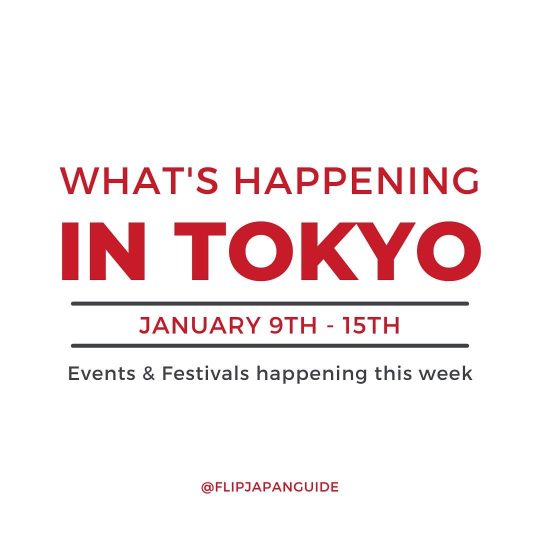
Some unique events happening for 2023 👀 🤩 Here are some amazing traditional Japanese events and festivals happening this week! 🤗 Full disclaimer, a few of these events are not in Tokyo, but in a neighbouring prefecture. For these events, you can visit on a day trip or even an overnight getaway! 📣 📣 📣 If you want all the events, information, official website, links etc, just DM "Events" @flipjapanguide and we will send it straight into your inbox 👉 Kamakura Ebisu 鎌倉えびす Hongakuji Temple 本覚寺 Kanagawa January 10, 2023 👉 Shunto Festival 春渡祭 Imamiya Shrine 今宮神社 Tochigi January 10, 2023 👉 Ome Daruma Market 青梅だるま市 Sumiyoshi Shrine 住吉神社 Ome, Tokyo January 12th, 2023 東京都青梅市本町192 👉 Oiso no Sagicho 大磯の左義長 Oiso Kitahama Beach 大磯北浜海岸 Kanagawa January 14, 2023 👉 Furusato Matsuri Tokyo ふるさと祭り東京 Tokyo Dome 東京ドーム Bunkyo, Tokyo January 13, 2023 (Friday) to January 22, 2023 (Sunday) 👉 Daikoku Festival だいこく祭 Kanda Shrine 神田明神 Chiyoda, Tokyo January 14th 👉 Toride Dondo Festival とりで利根川どんどまつり Toride Green Sports Park 取手緑地運動公園 Ibaraki January 14th 👉 Chakkirako チャッキラコ Kainan Shrine 海南神社 Kanagawa January 15, 2022 Follow @flipjapanguide to stay up to date on events, festivals, matsuri and all things Japan! #tokyonow #matsuri #japanfestival #japanesefestivals #tokyolife #tokyoevent #tokyoevents #tokyolifestyle #japanlife #japanlifestyle #traveljapan #visitjapan #visitjapanjp #discovertokyo #exploretokyo #exploringtokyo #livingintokyo #tokyolife #tokyoculture #tokyoevent #tokyoevents #tokyoexpat #tokyolover #tokyotokyo #tokyotravel #tokyotrip #tokyotrips #japantravelguide #japanguide #japantravel #japantraveller #japantraveler (at Tokyo, Japan) https://www.instagram.com/p/CnMPztVydjV/?igshid=NGJjMDIxMWI=
#tokyonow#matsuri#japanfestival#japanesefestivals#tokyolife#tokyoevent#tokyoevents#tokyolifestyle#japanlife#japanlifestyle#traveljapan#visitjapan#visitjapanjp#discovertokyo#exploretokyo#exploringtokyo#livingintokyo#tokyoculture#tokyoexpat#tokyolover#tokyotokyo#tokyotravel#tokyotrip#tokyotrips#japantravelguide#japanguide#japantravel#japantraveller#japantraveler
0 notes
Text
Willows Hotel Osaka Shin-Imamiya will hold a lunar eclipse viewing event on November 8. Also, experience piloting YAOKI, a lunar exploration robot.
Willows Hotel Osaka Shin-Imamiya will hold a lunar eclipse viewing event on November 8. Also, experience piloting YAOKI, a lunar exploration robot.
Willows Hotel Osaka Shin-Imamiya (2-1-24, Ebisu-Higashi, Naniwa-ku, Osaka City), operated by Nihon Unisto, will hold a lunar eclipse observation event and a hands-on experience with the YAOKI private lunar robot in conjunction with the total lunar eclipse on November 8.
A total lunar eclipse will be observable throughout Japan for the first time in 3 years and 10 months. On the day of the event,…
View On WordPress
0 notes
Text
Imamiya Ebisu


Yesterday at Imamiya Ebisu shrine, I wrote and hung up my first e-ma!
I visited countless temples and shrines on my last trip, between Tokyo, Kamakura, and Kyoto, but I never wrote an e-ma (I just prayed and bought charms for my friends).
Imamiya Ebisu’s deity protects businesses, so make sure to wish for success of your or someone else’s business.
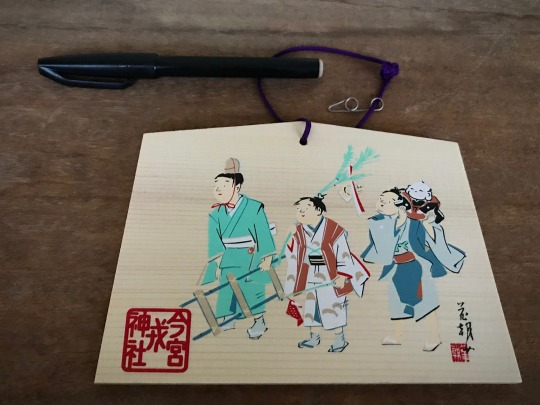
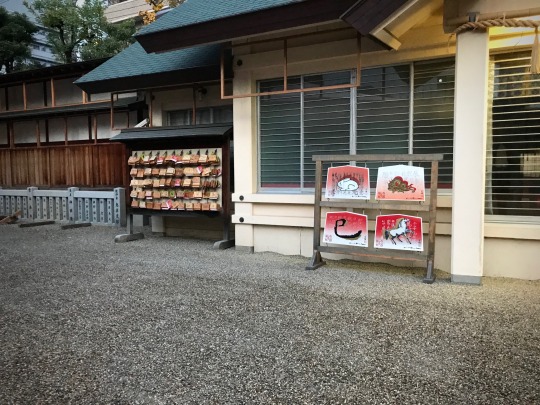
E-ma are wooden boards on which you write a prayer or wish, and hang it up. On a certain date, they are all taken down and burned at a ritual/event. Mine cost 1100 yen, and the money goes towards upkeep of the shrine. You need to buy it at the shrine office, where charms and amulets are sold - e-ma seem not to be displayed so you need to ask for it.
Another non-obvious item you can get is an omikuji. This is a paper fortune. The most important to know is that if you get a bad fortune, tie it onto a branch so you don’t take the curse with you! I haven’t gotten an omikuji yet because I’m not confident I’d be able to interpret it correctly 😅
Don’t forget to rinse your hands at the chouzuya before doing anything - there is a good shrine and temple etiquette guide here.
0 notes
Text

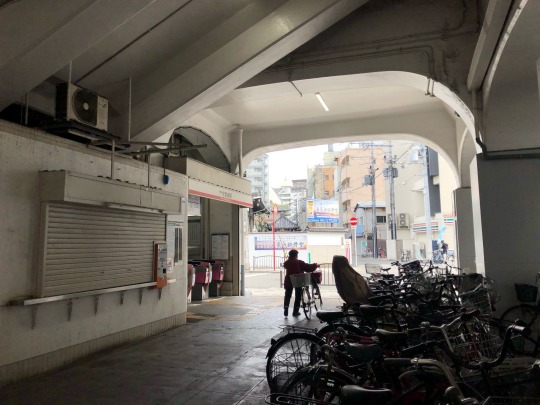

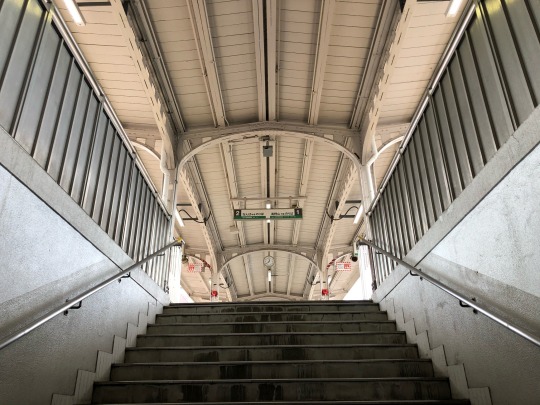
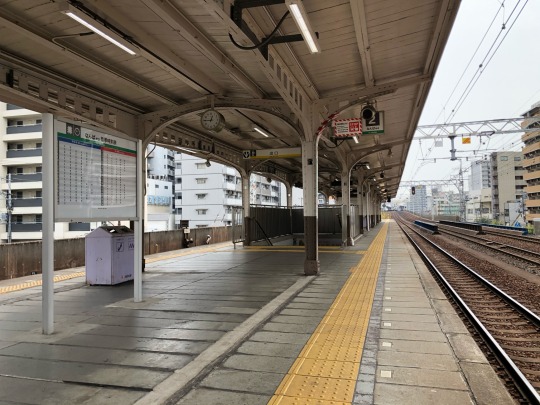
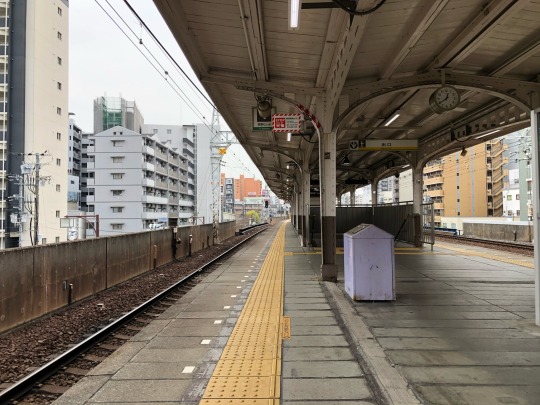


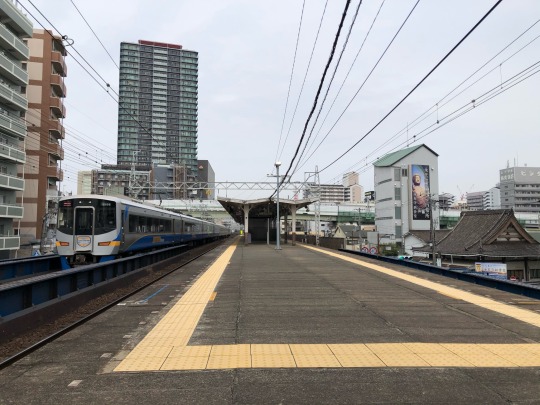
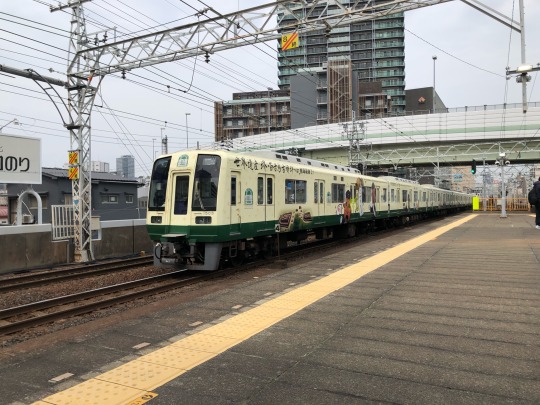
今宮戎駅 Imamiya-Ebisu Station
令和2年3月22日 2020-3-22
#今宮戎駅#南海電鉄#浪速区#大阪市#大阪府#Imamiya-Ebisu Sta.#Nankai Electric Railway#Naniwa Ward#Osaka City#Osata Pret.
20 notes
·
View notes
Video
今宮 えべっさん 福娘 2011 by MIXTRIBE
Via Flickr:
Imamiya Ebessan Fukumusume 2011
The Fukumusume will wear chihaya (a traditional Japanese dress) over their matching kimono and a gold karasuboshi hat on their heads.The Fukumusume are attracting a lot of attention from the girls and the entertainment community.
Qualifications for Fukumusume or Ebisu Musume are unmarried women between the ages of 18 and 23 (excluding high school students) who are chosen through a screening of documents and three interviews.
Tokaebisu is held lively at this Imamiya Ebisu every year from January 9 to 11. Translated with www.DeepL.com/Translator (free version)
【フォトギャラリー】今宮 えべっさん 福娘 2012
www.flickr.com/photos/mixtribe/sets/72157628848679311/
【フォトギャラリー】今宮 えべっさん 福娘 2013
www.flickr.com/photos/mixtribe/sets/72157632508164545/
Imaniya Yebisu Festival (osaka.Japan)
January 9 to the 11th is the Yebisu festival every year.
www.imamiya-ebisu.net/
#えべっさん#福娘#2011#今宮#大阪 今宮戎#福笹授与#福笹#事代主神#十日戎#エビス娘#商売繁盛#吉兆#神社#trip#travel#japan#osaka#巫女#巫女装束#Ritual#Shinto#miko#mico#imamiya#ebisu#shrine#Yebisu#festival#宝恵駕#flickr
19 notes
·
View notes
Photo

The Ebisu Festival on the Tenth Day of the First Month at Imamiya (Imamiya Toka Ebisu), from the series "Famous Views of Osaka (Naniwa meisho zue)", Utagawa Hiroshige, 1829, Art Institute of Chicago: Asian Art
Clarence Buckingham Collection
Size: 22.1 x 34.7 cm (8 11/16 x 13 5/8 in.)
Medium: Color woodblock print; oban
https://www.artic.edu/artworks/26685/
14 notes
·
View notes
Text
About日本製[Nihonsei] Part 2
〜Contents〜
Traveling 47 prefectures across Japan with Haruma Miura
47 of “Made in Japan”
01 Hokkaido A close look at the history of Esashi Oiwake
02 Aomori Artist’s techniques behind the Nebuta festival
03 Iwate Visiting Tekiseisha, a workshop for Joboji Urushi lacquer
04 Miyagi Kanedai, the pride of local industry
05 Akita Encounter a power of sake at the Aramasa Sake Brewery
06 Yamagata Visiting a Yonezawa beef cattle farm
07 Fukushima The world’s best rice – visiting the Tenei rice farm
08 Ibaraki Fireworks artistry of Yamazaki Enka Manufacturing
09 Tochigi The story historic Ashikaga School tells us
10 Gunma Daimonya, the history and tradition of Takasaki Daruma craftmanship
11 Saitama Ogano Kabuki, the tradition that passed down through generations and to the future
12 Chiba Learning at the Chiba Shoyu headquarters factory
13 Tokyo History of Tsukudani unfolded at Tsukudani Marukyu
14 Kanagawa Visiting Hakkodo, the oldest manufacturer of Kamakura-bori
15 Niigata Snow Peak headquarters and outdoor gear industry
16 Toyama Massive Kurobe Dam and electric power
17 Ishikawa What Kagaya Ryokan continues to deliver
18 Fukui The glasses I touched at the Boston Club in Sabae City
19 Yamanashi Hands-on report from Kikuchi Wasabi Farm
20 Nagano To the factory house of Fujigen Guitars
21 Gifu Japanese papermaking at Minotake Kami Studio
22 Shizuoka Think about a “community” at Dot Tree Project Shuzenji
23 Aichi Touch the origin of the Toyota Motor Corporation
24 Mie Wagu – soak-up the life of Japanese lobster fisherman
25 Shiga To Daiyo- Oumi’s hand-crafted Japanese candle
26 Kyoto Discover “Project GO ON” launched by a new generation of Kyoto traditional artists
27 Osaka Visiting Ebisu at the Imamiya Shrine
28 Hyogo The weight of the salt at the Ako Marine Science Museum, Salt Country
29 Nara Carrying on the traditions to future generation at the Yamamoto Kawara Kogyo
30 Wakayama Savoring Hamadaya’s sesame tofu at the foot of Mt. Koya
31 Tottori A challenge called Sakyu Rakkyo
32 Shimane The nature and the time that support Tataraba
33 Okayama The garment factory that shines, fueling Japan Blue in the denim industry
34 Hiroshima Interview with Mr. Fumiaki Kajiya, a storyteller of Hiroshima
35 Yamaguchi Family ties at Sakae Fuku, an exquisite pufferfish restaurant
36 Tokushima Fascinated by the BUAISOU’s indigo dye
37 Kagawa Discovering the history of udon noodles at the Sanuki Menki headquarters
38 Ehime The branding of Imabari Towel
39 Kouchi Mr. Manabu Myojin, the distinguished technique of the bonito fisherman
40 Fukuoka Hakata vidro chanpon artisan, Mr. Youji Kunii and his studio
41 Saga The alure of “Tadarou-ware pottery” encountered at Kaneko Kilin
42 Nagasaki Iki – the history of Hirayama Ryokan and the island
43 Kumamoto Tenmeido – Interview with Mr. Kazuki Kitagawa about “Rokkasho -six confectioners”
44 Oita Searching for Shiramizu Kousen’s sparkling water
45 Miyazaki Visiting the third generation of Kagura mask-making craftsman
46 Kagoshima To the JAXA Tanegashima Space Center
47 Okinawa Visiting the art of Kumiodori at the National Theatre Okinawa

2 notes
·
View notes
Photo

Desde mitologiainfo Visite:https://www.mitologia.info/ebisu/ #ebisu Es la deidad con más reconocimiento debido a que Ebisu es entre los dioses japoneses conocido como el dios de la fortuna, quien llevaba siempre una caña de pescar y un pescado. Venerado entre los pescadores por traerles buena suerte en su oficio, generándoles prosperidad a través de la pesca y el comercio de la misma, como también es el dios de los agricultores y mercaderes. Es el único de los siete dioses de la buena suerte que su origen es netamente japonés, es tan adorado que fue hecha una estatua en conmemoración del dios Ebisu. Este dios también ha sido bordado en telas y lienzos, y le han otorgado el honor de ser el guardián de la salud de los niños. Según la leyenda uno de los nombres del dios Ebisu es Kotoshronushi-no-mikoto y en el territorio de Kansaí el pueblo lo llama Ebessan. Existe un santuario de imamiya-ebisujinja el cual está dedicado a la diosa del sol, Ebisu y otros dioses. Se conoce que es uno de los dioses del linaje que existió antes que los dioses celestiales descendieran desde lo alto al archipiélago de Japón. Es uno de los dioses que recibe un millón de visitas por los que confían plenamente en su prosperidad, esto sucede en varios santuarios dedicados a este dios. Festivales de Ebisu En la región de kansai se realizan muy buenos festivales del dios Ebisu, muy parecidos a los celebrados de tori-noi-chi también conocido como feria del Ave, en la región de Kanto. Una de las diferencias en los festivales de tori-noi-chi, y el santuario de Otori-jinja en Asakura, los amuletos se atan a los rastrillos, Kumade, en vez del aventador. Es admirable como un pueblo agradece la prosperidad que le otorga su dios realizando festivales y de esta manera honrándolo cada año para que la riqueza cultural pase de generación en generación. #nippon #nipposfera #japon #japan #folklorejapones #losietediosesdelafortuna #diosesjaponeses #mitologíajaponesa https://www.instagram.com/p/B2mG79MF-gM/?igshid=pc2ph2gk68iw
#ebisu#nippon#nipposfera#japon#japan#folklorejapones#losietediosesdelafortuna#diosesjaponeses#mitologíajaponesa
1 note
·
View note
Photo

Toka Ebisu Festival is a religious ceremony held just a week after Osaka’s New Year celebration. People flock to Imamiya Ebisu Shrine to partake in a ceremony locally known as Ebessan to pray for wealth and fortune.
As a merchant town, Osaka celebrates this tradition to pray to Ebisu, the god of commerce, for financial success in the coming new year.
More than 3,000 women apply as fukumusume or “lucky daughters” but only 50 women are chosen as representatives each year.
Expect the streets of Osaka to be flooded with yatai stands with a variety of Japanese street food like takoyaki, grilled pork skewers, yakisoba, and so much more. You can take your time trying some of these before going to the shrine.
There are also stalls where you can buy good luck charms and offerings for Ebisu, but they can be a bit expensive. However, there are also free fukusasa good luck bamboo branches that people carry around. The fukumusume, also known as the lucky daughters, distribute these charms, and you can easily spot them with their traditional eboshi hats.
0 notes
Photo

Couleur Kaki (à l'époque des Koyo (feuille rouge) retardé par le beau temps). Sanctuaire Imamiya Ebisu-jinja, Osaka, Japon. (à 今宮戎神社) https://www.instagram.com/p/B4wqeNxIq5t/?igshid=exezs5ysu6x4
0 notes
Photo

I had a wonderful day out with friends for lunch and then to the big #Ebisu festival here in Osaka! ❤️⛩🙏 #十日恵比寿 (at Imamiya Ebisu Shrine) https://www.instagram.com/p/BsfewcNnL8Q/?utm_source=ig_tumblr_share&igshid=fqj3jddwt1ly
0 notes
Photo

こんにちは🌞 何とかえべっさん行けました⛩🎋 昨晩はTI3会とごい会に連日盛り上がってました✨ありがとうございます。 本日も13時よりオープン‼️ご来店お待ちしております♪ #デザスプ #ボードゲーム #ボドゲカフェ #天王寺 #阿部野 #昭和町 (Imamiya Ebisu Shrine) https://www.instagram.com/p/BsenWr9DIie/?utm_source=ig_tumblr_share&igshid=1q45aihg4hx9m
0 notes
Text
Du lịch Osaka đừng quên ghé thăm 5 ngôi đền độc đáo này
Bên cạnh Phật Giáo, Shinto (神道) hay còn được gọi bằng cái tên là “Kami no Michi” là tôn giáo bản địa có số lượng tín đồ nhiều nhất tại Nhật Bản. Mà nhắc đến Shinto thì chúng ta lại nhớ đến những ngôi đền lớn thờ cúng các vị thần tập trung ở Osaka. Nếu có dịp du lịch đến hòn đảo lớn nhất Nhật Bản, đừng quên thêm vào những ngôi đền Osaka sau đây vào danh sách điểm đến của bạn nhé.
1. Đền thờ Taiheji – nơi dừng chân của Phật
Taiheji rực rỡ về đêm
Phật Giáo là tôn giáo lớn thứ hai tại Nhật Bản (bên cạnh Shinto). Vì vậy, có nhiều chùa chiền đẹp tại “Đất nước mặt trời mọc” để bạn ghé thăm thưởng thức kiến trúc và tìm hiểu về Phật giá bản địa.
Taiheji là một trong những ngôi chùa nổi tiếng nhất tại Osaka nói riêng và Nhật Bản nói chung, nơi lưu giữ dấu ấn kiến trúc Phật Giáo và nhiều sự tích xa xưa để lưu truyền lại cho các thế hệ sau này. Đền Osaka này là một trong mười ba vùng đất Phật, vì thế ngôi chùa là di tích quan trọng đối với người dân Nhật Bản.
2. Đền thờ Tenmangu – nơi thờ thần học vấn
Tenmangu được xây dựng vào thế kỷ thứ 10 nhưng bị phá hủy trong một cuộc hỏa hoạn và được đại trùng tu vào năm 1845 theo nguyên bản ban đầu. Ngôi đền có giá trị lịch sử, là nơi thờ phụng Sugawara Michizane – một quan đại thần, một nhà thơ lớn vào thế kỷ thứ 10. Ông được người dân phong thần và trở thành nơi để sĩ tử đến để cầu xin sự may mắn trên con đường học vấn, thi cử.
Tenmangu – nơi sĩ tử đến xin sự may mắn trong thi cử
Phía bắc khuôn viên là hồ nước có tên gọi là “Hoshiai no Ike” có nghĩa là “hồ nước nơi các vì sao hội tụ”. Xung quanh hồ, cây ume (mai nhật) nở rộ trong khoảng từ cuối tháng 2 đến giữa tháng 3 hàng năm.
Đặc biệt, đền Osaka này còn nổi tiếng với lễ hội Tenjin Matsuri được tổ chức để tôn vinh Sugawara Michizane. Trong lễ hội, một kiệu có mái che với tượng thần diễu hành khắp khu vực xung quanh.
3. Đền Sumiyoshi – ngôi đền quyền năng
Đền Osaka Sumiyoshi Taisha là ngôi đền nổi tiếng nhất trong hệ thống đền Sumiyoshi Jinja. Được xây dựng vào thế kỷ thứ 3, tính đến nay đền đã có lịch sử hơn 1.800 năm tuổi. Không chỉ nổi tiếng tại Osaka, Sumiyoshi còn rất nổi tiếng khắp xứ sở Phù Tang, hàng năm thu hút hơn 2.000.000 lượt khách du lịch viếng đền.
Sumiyoshi Taisha – ngôi đền lớn nhất trong hệ thống đền Sumiyoshi-jinja
Sumiyoshi Taisha là một quần thể gồm nhiều đền thờ nhỏ đều liên quan đến hệ thống đền Sumiyoshi Jinja. Bước vào khuôn viên, bạn sẽ choáng ngợp với những kiến trúc cổ bằng đá bao gồm: cổng đá, đài đá và sân khấu nhạc. Đặc biệt, đài đá ngày nay vẫn còn được sử dụng để tổ chức Unoha Shinji múa hát vào tháng 5 hàng năm.
Ngoài ra, trong lúc tham quan đền, bạn còn có dịp chiêm ngưỡng cầu Soribashi – một trong 100 địa điểm ngắm cảnh về đêm đẹp nhất khu vực Kansai. Soribashi chính là cây Cầu đại diện Hoàng gia được xây dựng năm 1557 dành riêng cho Thiên hoàng và đại thần quý tộc đi qua đến thăm đền. Chỉ vào những dịp đặc biệt thì bậc thang mới được lắp vào để sử dụng cây cầu này.
4. Đền thờ Imamiya Ebisu-Jinja – nơi thờ thần tài
Đến Imamiya Ebisu-Jinja để xin sự may mắn trong kinh doanh
Imamiya Ebisu-Jinja là ngôi đền Osaka nổi tiếng được xây nên để thờ phụng thần kinh doanh. Mỗi năm từ 9/1 – 11/1, đền đều tổ chức lễ hội Ebisu thu hút du khách gần xa đến tham quan và thờ kính thần tài. Nơi đây, ngoài thần kinh doanh còn thờ cúng rất nhiều vị thần khác bao gồm thần Kotoshironushi-no-mikoto han còn được gọi là Ebisu san. Đây là vị thần ngư nghiệp được tạc tượng với tư thế cầm một con cá bên tay trái và một cần câu bên tay phải.
5. Chùa Hozen-Ji – ngôi chùa nổi tiếng với Thủy Quải Bất Động phủ đầy rêu
Tượng Hozen-Ji phủ đầy rêu tại Hozen-Ji
Chùa Hozen-Ji (Mizukake Fudo) là ngôi chùa được giáo phái jodo xây nên để thờ Phật A Di Đà Như Lai Thủy Quải Bất Động, Điện Kim Bì La,… và nổi tiếng nhất chính là Bất Động Minh Vương. Người bản địa thường gọi Bất Động Minh Vương là “Thủy Quải Bất Động” và sau khi cầu nguyện tình duyên viêm mãn hoặc kinh doanh thành công thì tưới nước lên tượng Phật. Qua thời gian, bức tượng Thủy Quải Bất Động phủ đầy rêu.
Du khách có thể tự do di chuyển trong khuyên viên của ngôi chùa. Phía Bắc của bức tượng Thủy Quải Bất Động là con đường Hozen-ji với nhiều cửa hàng ăn uống san sát được xây theo phong cách Nhật Bản lâu đời.
Trên đây là danh sách những đền Osaka nổi tiếng mà bạn nên viếng thăm một lần nếu muốn chiêm ngưỡng kiến trúc tôn giáo cổ của Nhật Bản và đắm mình trong không gian lễ hội truyền thống của đất nước Phù Tang. Hãy liên hệ với Ánh Dương Tours để được tư vấn miễn phí về các tour du lịch Nhật Bản thú vị, tiết kiệm và an toàn.
The post Du lịch Osaka đừng quên ghé thăm 5 ngôi đền độc đáo này appeared first on Ánh Dương Tours - Tính chuyên nghiệp tạo nên sự khác biệt.
source https://anhduongtours.vn/ghe-tham-5-ngoi-den-tai-osaka-nhat-ban/
0 notes